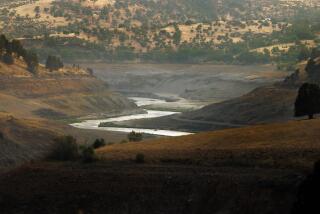Hoover Dam still stands as testament to American ingenuity
reporting from Boulder City, Nev. â Clayton Sellersâvoice echoes off the sheer rock walls that rise from his vantage point along the Colorado River in Black Canyon, just downstream from the base of Hoover Dam.
â[The dam] was started in 1931 and completed in 1935, about two years ahead of schedule and under budget,â he says as he maneuvers a pontoon raft across the water. Sellersâ passengers, mostly tourists staying in nearby Las Vegas, are awed by that fact, and even more so by the massive engineering marvel standing before them.
âItâs about 45 feet thick on top. At the very bottom itâs about 660 feet thick, which is like two American football fields and the end zones stuck end to end,â the guide continues. âThe concrete at the bottom has only been there about 75 years, so itâs not all the way dry yet. If you go inside the dam, thereâs actually some seepage ⦠through the wet layers of concrete.â
Despite the still-curing concrete, the iconic dam stands as a testament to American ingenuity, built during the Great Depression by thousands of men who uprooted their families and traveled to the inhospitable desert in search of work. There were jobs aplenty, and after the huge task was finished, President Franklin Roosevelt arrived on Sept. 30, 1935, to see for himself â and to dedicate â the modern-day wonder.
âThis is an engineering victory of the first order, another great achievement of American resourcefulness, skill and determination,â Roosevelt told a crowd of about 20,000. Millions more listened on their radios.
The dam, built to sate electricity-hungry Southern California and to stop devastating floods in the Imperial Valley, continues to welcome tourists. Soon, a new vantage point will join those in existence for decades.
From the sidewalks and road atop the dam, tourists are afforded views not only of the concrete hulk but also of the Colorado River and of Lake Mead, the vast body of water created by the construction.
Wearing hard hats, visitors venture into the bowels of the dam for an up-close view of the giant turbines, while guides provide insights into the technologies that were developed to make possible the enormous public works project.
Planning your tripTHE BEST WAY TO HOOVER DAM AND BOULDER CITY, NEV.
From Los Angeles, take Interstate 10 east to Interstate 15 north toward Las Vegas. Take Interstate 215 east to U.S. 93 south to Boulder City and the dam.
More than 5,000 men toiled day and night; 112 of them gave their lives. Coincidentally, the first and last workers to die were a father and son.
Through artifacts and a variety of fascinating photos, the human tale â and toll â of the damâs building is presented in the Boulder City/Hoover Dam Museum, in a historic hotel near the site of the tents and tarpaper shacks in which workers and their families lived.
â[Boulder City] was a federal reservation,â says Shirl Naegle, the museumâs manager and a nephew of two men who worked on the dam.
âIt was more like an Indian reservation than a company town,â he explains. âThe federal government controlled everything.â
Naegle notes that guard posts were erected in an effort to keep out booze, gambling and prostitution. The government also issued special currency, good only in Boulder City, but it failed to keep many from making the 30-mile journey along a new paved road to Las Vegas to patronize brothels and casinos.
Upon returning from a night on the town â or even after a sobering day at work â workers would often âcome homeâ to the shrieks of women other than their wives.
âThey [the shacks] all looked the same,â he says. âTheyâd get off shift and new houses would have been built [that day]. So theyâd walk into the wrong house.â
With its museum, several small restaurants and boutiques, Boulder City is well worth a stop en route to Hoover Dam â and a new, nearby attraction coming soon.
When it opens in November, the Mike OâCallaghan- Pat Tillman Memorial Bridgeâ known locally as the Hoover Dam Bypassâwill become the second engineering feat to link southern Nevada with northern Arizona.
Spanning more than 1,000 feet, the bridge stands 90 stories tall about a quarter-mile south of the dam. Itâs designed to ease congestion by allowing through traffic to bypass the visitor-laden, two-lane switchbacks leading to and from the dam.
With its towering location, the bridge will feature an overlook and parking lot on the Nevada side for those seeking a birdâs-eye view of the 1930s triumph.
Although the official name of the bridge â which honors a Nevada governor and an NFL player-turned-soldier â was never questioned, the same canât be said for the dam, which played the name game under three U.S. presidents.
First called Hoover Dam, after the Republican who was president when the project began, the designation suddenly changed to Boulder Dam after the election of Roosevelt, a Democrat, in 1932. It reverted to the original name during the administration of fellow Democrat Harry Truman.
<hr />
<a href=âhttp://ukobiw.net./features/food/la-tr-hooverdambox-20100926,0,3874782.storyâ>Planning your trip</a>
<p> </p>
<p><strong>THE BEST WAY TO HOOVER DAM AND BOULDER CITY, NEV.</strong></p>
<p><strong>From Los Angeles,</strong> take Interstate 10 east to Interstate 15 north toward Las Vegas. Take Interstate 215 east to U.S. 93 south to Boulder City and the dam.</p>
<p><a href=âhttp://ukobiw.net./features/food/la-tr-hooverdambox-20100926,0,3874782.storyâ>>> Read more</a></p>
<hr />
More to Read
Sign up for The Wild
Weâll help you find the best places to hike, bike and run, as well as the perfect silent spots for meditation and yoga.
You may occasionally receive promotional content from the Los Angeles Times.






